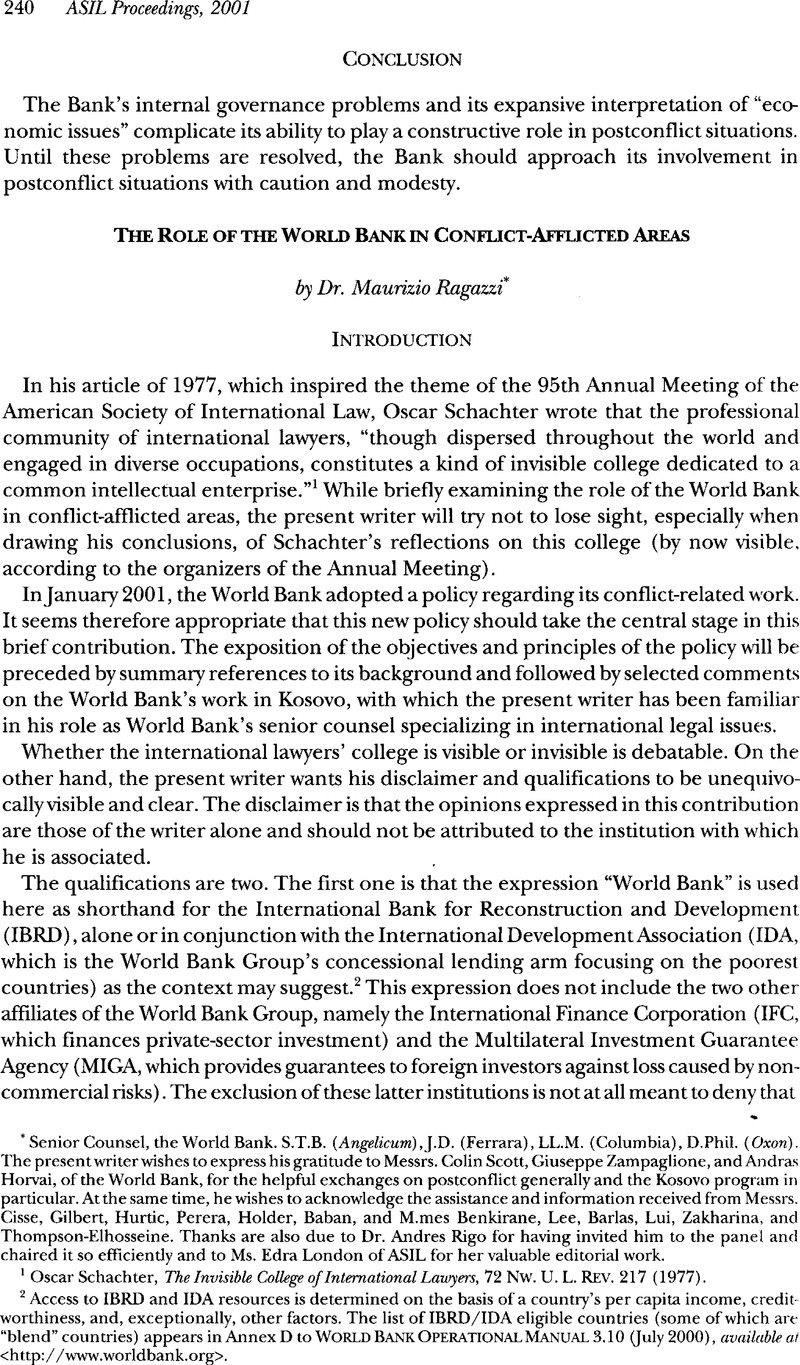Published online by Cambridge University Press: 28 February 2017

1 Schachter, Oscar, The Invisible College of International Lawyers, 72 Nw. U. L. Rev. 217 (1977)Google Scholar.
2 Access to IBRD and IDA resources is determined on the basis of a country’s per capita income, credit worthiness, and, exceptionally, other factors. The list of IBRD/IDA eligible countries (some of which are “blend” countries) appears in Annex D to World Bank Operational Manual 3.10 (July 2000), available at <http://www.worldbank.org>.
3 For the postconflict activities of these two institutions, see their respective Web sites, <http://www.ifc.org> and <http://www.miga.org>. (With respect to MIGA, see the information regarding the West Bank and Gaza Investment Guarantee Trust Fund and the European Union Investment Guarantee Trust Fund for Bosnia and Herzegovina.) The other Bretton Woods institution, the International Monetary Fund, extended in September 1995 its emergency assistance for natural disasters to cover certain postconflict situations. See IMF Executive Board Meeting 95/82 (Sept. 6, 1995).
4 The IBRD Articles of Agreement were adopted at the Bretton Woods Conference, July 1944. The Savannah Conference, with the inaugural meeting of governors, took place in March 1946. The first directors’ meeting took place in May 1946.
5 The very first loan on March 9, 1947, for an amount equivalent to $250 million, was made to Crédit National, a semi-public French corporation created to assist in financing reconstruction and development of the French economy. The loan was guaranteed by the French Republic. On the reconstruction loans to European countries, see Robert W. Oliver, International Economic Co-operation and the World bank 241-4 (1975).
6 See 1 The World Bank: Its First Half Century 71 (Devesh Kapur, John P. Lewis, & Richard Webb eds., 1997) ; Edward S. Mason & Robert E. Asher, The World Bank Since Bretton Woods 150 (1973).
7 Mason & Asher, supra note 6, at 153 (1973).
8 A revised version of this paper, The World Bank, Post-Conflict Reconstruction: The Role of the World Bank (1998), is available in printed form, and electronically at the World Bank’s Web site, <http:// www.worldbank.org>.
9 The findings of this assessment are summarized in Alcira Kreimer, John Eriksson, Robert Muscat, Margaret Arnold, & Colin Scott, The World Bank’s Experience with Post-Conflict Reconstruction (1998).
10 The need to bridge effectively humanitarian aid on the one hand, and reconstruction and development work on the other, is at the origin of the cooperation between the World Bank and the United Nations High Commissioner for Refugees.
11 See Ibrahim F.I. Shihata,3 The World Bank in a Changing World 155-86 (2000); see also Yokota, Yozo, Non-political Character of the World Bank, 20 Jap. Ann Int’l L. 39 (1976)Google Scholar. For critical remarks, within the wider and complex context of human rights, see Bradlow, Daniel D., The World Bank, the IMF, and Human Rights, 6 Transnat’l L. & Contemp. Probs. 47 (1996)Google Scholar.
12 See Ibrahim F. I. Shihata, The World Bank Legal Papers 531-52 (2000) ; Shihata, Ibrahim F. I., Abushaka, I. Hadi, & Gruss, Hans-Jürgen, Legal Aspects of the World Bank ‘s Assistance to the West Bank and the Gaza Strip, 7 Palestiney. B. Int’l L. 19 (1992/94)Google Scholar.
13 On the doctrine of implied powers, see Ian Brownlie, Principles of Public International Law 687-89 (5th ed. 1998). (The constituent instruments of IFC, IDA, and MIGA, unlike that of IBRD, contain a residual norm expressly providing for the possibility that these organizations may exercise such other powers incidental to their operations as necessary or desirable in furtherance of their purposes.)
14 United Nations, United Nations Interim Administration Mission in Kosovo, at <http://www.un.org/kosovo/index.html> For a comprehensive documentary background to the situation in Kosovo, see Weller, Marc, The Crisis in Kosovo 1989-1999 (1999)Google Scholar. On UNMIK, see Lagrange, Evelyne, La Mission intérimaire des Nations Unies au Kosovo, nouvel essai d’administration directe d’un territoire, 45 Annuaire Français de Droit International 335 (1999)CrossRefGoogle Scholar, and Garcia, Thierry, La Mission d’administration intérimaire des Nations Unies au Kosovo (MINUK), 104 Revue Generale De Droit International Public 61 (2000)Google Scholar. See also Matheson, Michael J., United Nations Governance of Postconflict Societies, 95 AJIL 76 (2001)CrossRefGoogle Scholar.
15 The United Nations organization has a similar agreement with IFC and IDA.
16 Details on the program are electronically available at the World Bank Web site, <http://www.worldbank.org>.
17 Schachter, supra note 1, at 223.
18 Id. at 217.